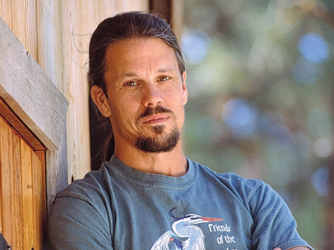Northwest Book Lovers asked me to write a guest blog. Here it is.
Notes from a Writing Life, an Essay by Charles Finn
Wednesday, April 25th, 2012
Filed under:NW Voices

photo by Lynn Donaldson
In the Beginning:
I sell my first piece of writing when I am in the second grade. It
is a screenplay for the TV series Star Trek. Proof of my precociousness
is written across the title page in my father’s neat, bold uppercase
hand: “PURCHASED FROM THE AUTHOR: 25¢.”
To this day, it is one of my larger paychecks, and even without
factoring in inflation, on a per-word basis, it far exceeds the advance
for my new book. This is just to say, I blame my father for all the
disappointment, all the glory that has followed.
The Rebel:
“Shize? I should shee! Macool, Macool, orra whyi did ye diie? of a
trying thirstay mournfn? Sobs they sighed at Fillagain’s chrissormiss
wake, all the hoolivans of the nation, prostrated in their consternation
and their duodisimally profusive plethora of ululation.” — James Joyce,
Finnegan’s Wake.
Eight years old and flush with commercial success, I move on to the
third grade, headstrong and confident, where I am forced to learn
grammar and spelling. Sadly, Mrs. Moore fails to realize I’m channeling
the great Irish novelist (my name is Finn, after all), and when it comes
time for class, I purposefully tune out. Life is hard, but I prevail. I
am a paid professional, an artist, an artiste! I don’t need no steekeen
rewlz.
I have paid the price ever since.
A Vague Memory:
High school, sitting at the kitchen table, homework and book reports
spread out across it, my mother showing how to link one thought to
another, how to tie one paragraph to the next.
I Emerge from my Shell:
1985, my sister, Mary, buys me a Eurail Pass to use after my semester
abroad in London. My eyes are finally opened. There is a world out
there and I am curious. I begin to write it down.
On the Shoulders of Giants:
In 1990, trekking in the Nepal Himalaya, I pass an outdoor table of used books and pick up a copy of
The Snow Leopard.
I am walking on the top of the world, and it feels like the top of my
head has blown off. A year later, browsing in the public library in
Kaslo, British Columbia, Canada, I hook a finger over the spine of
something called
Teaching a Stone to Talk.
I’ve never heard of it, but I like the title. By that afternoon my
world has changed. A year after that, working at an independent book
store, the owner hands me a copy of
American Primitive,
saying “I think you might like this.” I stand in the center of the
store and read the first three poems, whispering to myself, “Oh my God,
oh my God, oh my God.”
Peter, we have never met, but thank you. Annie, the same, I am much indebted. Mary, thank you, and bless you.
There have been many, many others. Too many to name. I am shades of all of them. I stand on the shoulders of giants.
Friends Come to Visit:
For 10 years I live in B.C., by the end of which I am living in a 12’
x 7’ gypsy wagon with no running water or electricity. I must walk
through the woods to use a friend’s computer to send submissions by
email. Elk, mountain lions, otters, birds and flying squirrels are my
neighbors. A mother bear and two cubs break into my cabin, wreck the
place, eat my butter and jam. Squirrels store mushrooms in my boots. On a
warm afternoon, I come inside from chopping wood and a red-shafted
flicker flaps at the window. My journal is a bestiary, and I have an
idea for a book.
Stars. Coincidences:
I move to Missoula, Montana and house-sit for a man who is dating
Gretel Ehrlich. She visits and we become friends. I look up into the night sky. I can feel the stars aligning.
That winter, I build a cabin and start a business building others. I
call it A Room of One’s Own. I pare down my belongings to next to
nothing. I read
Walden over
and over again. “Simplify, simplify.” My world is shrinking, but I am
growing by leaps and bounds. I live in a micro-home and am writing
micro-essays. It cannot be coincidental.
Love:
Behind every great artist is his or her spouse. At a mutual friend’s
house party in Missoula, I meet my future wife. We marry, six months
later, on Valentine’s day. I vow, “Until death do us part.”
Surprise:
Spring 2010, I have lunch with the editor of
High Desert Journal,
Elizabeth Quinn. The previous year she published a pair of my wildlife
micro-essays. Over tuna melts at the Pine Tavern in Bend, Oregon, she
asks me if I’d like to join the journal, help her out. “You could be the
editor,” she says. It is a normal day. A tree grows in the center of
the restaurant. I signal the waiter I need something stronger than beer
and don’t tell Elizabeth about the third grade.
Two Days Ago:
Two days ago, I have breakfast with
Terry Tempest Williams. She tells me what I already know: write what is in your heart.
I go home and begin, as I always do, all over again.


